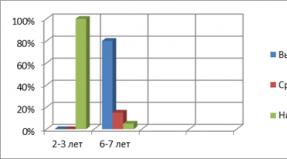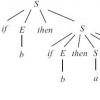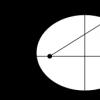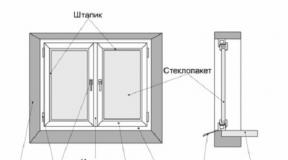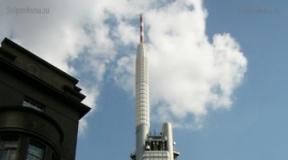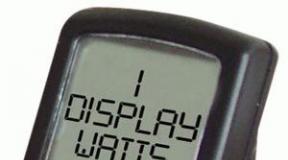Is there a large seam after cesarean. How long does the suture heal after cesarean? If threads come out after a cesarean section
Caesarean section is a type of surgical intervention in which the skin, subcutaneous and muscular layers, and also the uterus are cut in order to extract the baby. A neat suture must be applied after the caesarean section.
Healing takes place individually in each case. But first of all, it depends on the type of incision, seam, age of the woman in labor and her physique, as well as the correctness of compliance with all the doctor's recommendations.
So, what do mothers need to do and know so that childbirth and the postpartum period pass quickly and imperceptibly?
The most important thing after a cesarean section is to apply the suture correctly, quickly and accurately. In total, there are three stages in the implementation of the surgical procedure.
- Initially, a suture is applied to the uterus. In the operation, a cross-sectional incision is most often used, the total length of which reaches 11-12 centimeters. This is due to low blood loss and rapid healing.
- At the second stage of the operation, the sutures after the cesarean section are applied to the abdominal cover and muscles of the anterior cavity, as well as the tendons and subcutaneous fat. So that after the surgical intervention there are no traces left, surgeons use absorbable threads made of semi-synthetic material: vicryl, monocryl, and so on.
- The third stage is the stitching of the upper layers of the skin. It is carried out only in the direction in which the cut was made.
Types of incisions for cesarean section
In modern medicine, the following types of incisions are most often used:
- Excision of the anterior abdominal wall with a vertical incision. It is carried out in the direction from the navel to the pubis. It is used only in urgent situations.
- Pfannenstiel section. It looks like an arc running along the entire length of the suprapubic fold. After healing, it becomes almost invisible.
- Joel-Cohen excision. It is performed with a small incision between the pubis and the navel in horizontal position... Allows you to remove the baby as quickly and accurately as possible.

The Pfannenstiel and Joel-Cohen incisions are sutured with an internal suture, and the vertical incisions are sutured with absorbable sutures.
How to avoid complications after a cesarean section
Immediately after the operation, the woman in labor is transferred to the intensive care unit. Here she undergoes a thorough examination and control by medical personnel. In case of complications during a caesarean section, short-term antibiotic therapy is used - it does not entail negative consequences for the child's health. With a successful outcome of the operation, drug treatment is not required.
In order not to disperse the seam after a cesarean section, it is necessary to strictly follow the doctor's instructions, to avoid injury to the wound. The discrepancy can happen due to infection of the suture, improper wound closure technique.
In the first 24 hours, the woman in labor is replenished with blood lost during childbirth, and all life support systems are also supported. Special attention on the part of the medical staff is paid to vaginal discharge - if blood flows abundantly, the risk of uterine blood loss is high. In addition, in the intensive care unit, the mother is given droppers for two hours with drugs such as oxytocin and methylergometrine - they quickly contract the uterus - and also put an ice pack on the lower abdomen.
"Immediately after the operation, the patient must learn to turn from side to side, and by the end of the same day, gradually get up: first sit down in bed, then lower her feet to the floor, and then walk around the bed and around the ward with the help of medical personnel."
At the end of 6 days, an ultrasound scan is performed to check the contractile function of the uterus.
During all postoperative period dressing is changed, examination and treatment of seams with antiseptics. Stitches are removed after cesarean on the seventh day after surgery. Usually, immediately after this, the young mother and child are discharged home.

Suture removal and care in the hospital and at home
The stitches in the hospital are treated by medical personnel using antiseptic agents. The duration of complete healing, at the same time, directly depends on the operation performed and the conscientiousness of the woman in labor to care for the scar at home.
The suture is removed in the hospital a week later as follows:
- A knot is pinched off from one edge with a special tool, holding the threads together.
- The thread is picked up with tweezers and pulled out neatly.
Is it painful to remove stitches after a cesarean? There is no definite answer to this. It all depends on the sensitivity of the patient. A properly performed stitch removal procedure should not cause severe pain.
Before being discharged home, the patient receives detailed medical advice on the rules of behavior during the healing period, as well as necessary measures to prevent complications.

So, mom, after a cesarean section at home, it is strictly forbidden to perform the following actions:
- Lift weights. These include all items that exceed the weight of the newborn.
- Exercise. These include strength training or house cleaning.
- Lie in bed for a long time. With little movement, the scar hurts especially for a long time. This is due to stagnation of blood in the small pelvis.
- Rub or squeeze the seam. With excessive discomfort, the scar can become inflamed and cause complications.
“If a suture ooses after a cesarean - even a week after treatment - the wound needs to be cleaned. Brilliant green or iodine is used for this, while the skin around the scar is lubricated. "
And what is allowed? The following actions:
- Wearing a fixation belt on the abdomen (bandage).
- Take a warm shower. The use of a washcloth is not allowed.
- Maintaining a diet for the entire healing period.
- Blowing warm air around the abdomen for 30 minutes.
Possible Difficulties with Suture Healing
Quite often, mothers are interested in the question: how much does the seam heal after cesarean? The answer directly depends on the type of suture and possible difficulties with healing. So, there are primary and secondary complications. The first group includes:
Soreness
Immediately after the incision in the anterior abdominal wall, the patient experiences pain that disappears only after a few weeks or months. To reduce its effect, pain relievers are administered:
- on the first day: tramadol, morphine and other drugs.
- during the next week: analgin, ketanov or ketanol, diphenhydramine.
The seam after a cesarean section hurts in each patient in different ways - it all depends on the type of incision: vertical - up to 60 days, horizontal - up to one and a half months.
Density of seams
Hardness for 60 days is a completely normal and natural phenomenon: during this period, complete healing is carried out. The scar becomes soft only after a couple of years: the longitudinal scar passes after a year and a half, and the transverse scar - after 12 months.
“Quite often women have a small crease above the seams. It is not dangerous, but only in the absence of pus and pain. The fold promotes rapid tissue healing. However, the presence of a lump should alert: it can be either a kind of scarring or a malignant formation. "
Seam ridge
If the stitches are removed, but the scar gets wet within the first 7 days, then there is nothing wrong with that: this is how healing occurs. However, if there is bad smell, color or blood is recommended to see a doctor right away.
Unpleasant sensations
Does the scar itch badly? It's okay: any cosmetic suture after a cesarean, healing and tightening, itches a lot. It is strictly forbidden to scratch or touch the seam! If the scar bakes strongly, this is a reason to consult your doctor.
Secondary complications include those that appear six months or longer after a cesarean section. These include a ligature fistula. This is a disease resulting from the rejection of threads by the body. It is characterized by a gradual deterioration:
- A small swelling forms first.
- Then red spots appear.
- Soreness appears.
- Pus is formed.
In this case, the edges of the wound can disperse, and then converge again - due to a small thread sticking out in it. In this case, you cannot process the seam yourself. You should consult a doctor in a timely manner, who will gently pull the thread.
Physical recovery after cesarean
During the recovery and healing of the scar, it is not allowed to conduct a strong physical activity... However, light gymnastics is quite acceptable - even 6 hours after the operation. It is carried out as follows:
- Light strokes on the abdomen with cruciform movements for 3 minutes.
- Massaging the front and sides of the chest from the waist to the armpit.
- Stroking the back with the wrists and palms from top to bottom and from left to right.
- Deep breathing with the chest, and then with the abdomen, holding the hands, alternately, in the area chest and seams.
- Rotational movements of the feet, as well as alternating movements of the legs for flexion and extension.
The processing of the suture that remained after the cesarean section is a rather significant aspect, on which not only the speed of wound tightening depends, but also the overall duration of recovery. While the patient is in the hospital, the nurse performs all the necessary manipulations. But after discharge, the situation is completely under the control of the woman in labor. Further, in detail about how to properly care for the wound left as a result of a cesarean section, as well as signs indicating the need to see a doctor.
Problems with stitches in the first weeks after surgery
It is necessary to process the scar after a cesarean section very carefully, observing all the rules of hygiene and sanitation. The danger is that during and after surgery, the risk of developing various bacterial infections is very high. Talk about possible complications may be the symptoms described below.
Pain
The discomfort pain after surgery are inevitable. Unpleasant phenomena are caused by the fact that the operation involves a violation of the integrity of the ligaments, muscles and skin. In addition, the uterus after childbirth is actively contracting, assuming its usual size. During this period, sharp tingling sensations may occur, which the woman takes for pain in the seam.
Pain syndrome can also be caused by pathologies, including:
- ... With this disease, the focus of inflammation develops on the uterine membrane, affecting the internal seams. May be accompanied by secretion with a putrid odor, high (possibly subfebrile) body temperature. At the first symptoms, an immediate visit to a doctor is necessary, who will select antibacterial or anti-inflammatory drugs.
- Seam divergence. It develops in the event of an infection in the wound. Reoperation is often required to correct the problem.
- Adhesion processes. They are accompanied by sharp pain on palpation, nausea, weakness, and digestive disorders. Healed tissues do not dissolve on their own, laparoscopy is indicated.
- Ingrowth of nerve endings into the scar. Painful sensations will gradually pass on their own, at first after the operation, to relieve the condition, the mother is prescribed antispasmodics or analgesics.
Pain can also occur due to congestion. Impaired peristalsis and difficult progress feces cause pressure on the walls of the uterus. Often, patients with similar complications are advised to empty their bowels by means of an enema.
Seam hardness
It is important to be sure to take into account the accompanying symptoms. If the suture is not only hard, but also discolored, hot, painful when touched, or, even worse, the scar is oozing, there is a high risk of a serious complication. With timely provided medical care it will not be difficult to solve the problem.
Did the doctor advise you about the treatment of the seam?
YesNo
The reason for the hardness of the suture on the abdomen after a cesarean section may also be keloid scar, that is, a lump that is formed as a result of the growth of tissue layers. This is not a complication, but rather a cosmetic defect that can be easily eliminated conservatively or surgically after the wound has completely healed.
Seam discharge
If the postoperative scar begins to ooze, it is necessary to urgently inform the attending physician about it.
Based on the intensity of the discharge from the scar, the nature and cause of complications, the patient is cleaned or probed. In the most difficult cases, they resort to excision of the damaged tissue or to the complete removal of the stitches.
Itching
This indicator can be considered positive (unless the itching is complicated by purulent secretion and pain), since it indicates that the wound is healing and damaged tissues are being restored. The scar after a cesarean section will scratch for a long time - it all depends on the size of the incision. To alleviate discomfort, antipruritic ointments and creams can be included in caring procedures, having previously consulted with an obstetrician-gynecologist about their use.
How and with what to treat a seam after a cesarean section
When the patient's recovery is stable, on the 6-8th day (if silk materials were applied, and the catgut dissolves on its own after a couple of months). The doctor monitors the condition of the scar for several days, and in the absence of pathologies, he lets the young mother and the newborn go home. Before discharge, the patient is given detailed instructions on how to process the seam left after the cesarean section.
As a standard, seam care involves the use of:
- Bepanten. Cream that helps to accelerate the healing of the wound area. Safe and efficient. It is quickly absorbed, does not cause irritation and allergies.
- Ointment Vishnevsky or Liniment Balsamic. The tool is effective and safe, as it is made from natural ingredients. It is applied easily - with a bandage swab, it is well absorbed. But before you smear a scar after a cesarean, it must be treated.
- Chlorhexidine. Used for surface disinfection. Offered in pharmacies as a spray and solution. Apply with a sterile cotton swab.
- Zelenki. It can be combined with or substituted for Chlorhexidine. Provides good protection against bacteria, but may cause an allergic reaction.
Seam care at home
How quickly the suture heals after a cesarean section depends not only on how the woman in labor treats it at home, but also how correctly she does it.
Self-care for an unhealed wound necessarily implies:
- washing hands with antibacterial soap after using the toilet;
- compliance with the rules of intimate hygiene;
- wearing natural cotton underwear;
- using only sterile dressings (cotton wool, bandages, gauze).
Important! It is necessary to start treating the scar only after taking a shower. When bathing, it is forbidden to use a washcloth in the wound area or rub it with a brush. Physical impact may cause bleeding or rupture of the suture.
Until the seam is completely overgrown (the degree of healing is determined by the doctor during the examination), the woman in labor is prohibited from heavy physical labor, lifting weights. It is necessary to avoid work that is associated with squats, bends, tension of the abdominal muscles. Being at home, a woman should carefully monitor the condition of the wound, monitor the speed of formation keloid... If any suspicious symptoms appear, a visit to the clinic is required.
How long does it take to process the seam after cesarean
It is impossible to say exactly how many days you need to perform caring procedures. This indicator depends not so much on the professionalism of the surgeon involved in the operation, as on the characteristics of the mother's body. In most cases (in the absence of complications) the suture is tightened after 4–6 weeks.
But if we talk about the complete formation of the scar, then this process takes a long time - about a year. And how much the result will please from an aesthetic point of view, just depends on how much and how well the seam was processed after cesarean.
Opinion of doctors
Recommendations on the best way to handle the seam after a cesarean section are given by an obstetrician-gynecologist of the highest category Evgeny Surin: “For some reason, many patients who have undergone surgery are most worried about the fact that they will not be able to take care of the scar at home. Some people are even afraid to be discharged because of this. In fact, none of the hospitals (maternity wards, too) have some special medicines that cannot be bought at a regular pharmacy. Our nurses use good old brilliant green and the usual Chlorhexidine, which costs a mere penny, when processing seams. In this matter, it is important, first of all, to observe the rules of sanitation and personal hygiene. And absolutely any woman can cope with the dressing. Therefore, there is no reason to worry and stay in the hospital, except for cases when the woman in labor needs additional treatment. "
After a cesarean section, scars always remain. After all, this is an abdominal and very serious operation, and stitches after it, alas, are inevitable. About what they are, how to take care of them, what complications can be, we will tell you in this article.

Views
The obstetric caesarean section is performed with a mandatory autopsy abdominal cavity Also, incisions are made in the adipose and muscle tissue, on the uterus itself. Through them, the baby and the placenta are taken out into the light. After removing the baby and the "child's place", all incisions are sutured. To do this, use different suture techniques and different surgical suture material. The sutures on the uterus are called internal, and turn into a scar, and the sutures on the abdominal wall are called external, and turn into a postoperative scar.
Internal
If a caesarean section is done routinely, doctors usually try to make a horizontal incision in the lower segment of the uterus. For emergency surgery, a vertical incision can be made to speed up the process. The uterus is dissected in the same way as the outer layers.
The methods by which such sutures are applied can be different - each surgeon has his own method of suturing in service, the main requirement for such sutures is the most accurate coincidence of the wound edges. This is important for the formation of a full-fledged scar in the future. The materials used for suturing dissolve on their own; of course, it is not necessary to remove such sutures. They do not require any special care, it is enough to follow the doctor's recommendations on the exercise regimen and the prevention of infections.
A single, continuous suture is usually placed on the uterus. Muscles are sutured with stitches. The connective tissue of the peritoneum is also sutured with self-absorbable suture material.


External
The external suture depends on the choice of the surgical technique. If it is carried out urgently, it is possible that not the most beautiful scar from the navel to the pubis will appear. Such a suture is sutured with especially strong threads and connected by a nodular method, because it is more difficult to keep the edges of the external wound with a corporal longitudinal dissection than with a small transverse suture along the pubic line. Fortunately, today all planned operations and a good half of emergency operations are performed according to the Pfannenstiel method - the German doctor who was the first to practice this type of incision.
With a relatively small size, such a suture may well be cosmetic, which cannot be said about corporal dissection. For fastening the edges of the wound from the outside can be used different types surgical sutures or metal staples.



Classification of external seams
Naturally, the woman herself is unable to see the internal seams. But external ones can be quite perceptibly disturbing. Indeed, different types of external postoperative scars have their own characteristics.

Horizontal
The Pfannenstiel section is considered the least traumatic. The surgeon's scalpel runs only along the edge of the abdominal cavity, in the natural fold of skin above the pubis. Such an operation is considered not only less dangerous, but also more favorable for women planning their next pregnancies through a caesarean section. The lower uterine segment, where the incision will take place, is least of all subject to stretching.
The seam looks pretty neat. If you take proper care of him, that in one and a half - two years he will be almost imperceptible. It is very convenient to mask the location of the seam with underwear. The seam is perfectly closed with panties or swimsuit trunks. The woman's belly does not disfigure.
The length of the seam with such a cut is no more than 10 centimeters. There is another type of horizontal dissection - extreperitoneal, when the incision is made very small - 2-3 centimeters under the navel line. But such a cesarean section is extremely rare, since the operation is technically very difficult and involves certain risks for the mother and fetus.

Vertical
A vertical or corporal seam is always an urgent need. This type of operation is performed if the child needs to be removed as soon as possible - an abundant uterine bleeding, the baby has a state of acute hypoxia, in which he is threatened with death or the onset of severe health consequences.
It is impossible to hide such a seam under the line of panties or swimming trunks. It is coarser because the suturing technique is nodular. Moreover, over time, such a seam tends to thicken and become more noticeable and unpleasant.

Healing mechanism
The healing time and the likelihood of complications also depend on what type of incision and what type of suturing was used by the surgeon.
Interior
Internal sutures will heal in about 7-8 weeks. On the first day after the operation, the so-called adhesion zones are formed, consisting of fibrin bundles. This is why it is important to limit harsh movements, although early, gentle verticalization will be beneficial.
A week after the operation, the internal scar on the uterus already has new cells of the uterine tissue, and the blood network is restored. If the healing proceeds normally, without complications, then myocytes will prevail in the scar, and collagen will be produced, which will provide the scars with usefulness and elasticity. This is very important for the subsequent gestation.

If the recovery process is disrupted, a scar with a predominance of rough connective tissue, defective and heterogeneous, which will greatly complicate the subsequent pregnancy and childbirth.
The internal suture cannot completely disappear, the scar remains forever, and the more wealthy it is, the higher the chances of having a second child on their own, without the help of surgeons, if there was only one cesarean section in the history. The complete formation of the scar is completed 2 years after the operation.

External
The healing depends on the type of scar. A vertical suture left after an emergency corporal section heals longer, and the likelihood of complications with such a scar is higher. The external suture after horizontal dissection in the lower uterine segment begins to tighten on the next day after the operation, after 7-8 days the sutures can be removed.
Earlier, when women were in the hospital for up to 10 days after the operative delivery, the stitches were removed in the maternity hospital. Now, when a woman and a child are discharged on the fifth day after the operation (in the absence of other complications), the stitches are removed in the antenatal clinic for 7-8 days. The procedure is painless, although not the most pleasant one. After the sutures or staples are removed, the suture continues to form and it can take up to 21 days for complete healing. The vertical suture heals up to 60 days.

A year after the operation, the horizontal suture in the lower segment of the uterus brightens and becomes almost invisible.
Recovery features
Since the seam is the junction of the dissected tissues, one should be aware that during the surgical intervention, not only the skin, muscles, but also the nerve endings are dissected. Therefore, two postoperative sensations are quite normal - numbness in the upper abdomen (due to loss of sensitivity after dissecting the nerves) and pain (for the same reason). What else can a woman face in the postoperative period?

Painful sensations
The pain is most severe in the first 2-3 days, which is why the woman is injected with painkillers at this time. This is necessary to make it easier to endure the contractions of the uterus with the incision. But after 2-3 days, the nerve fibers damaged during the operation are replaced by new neuromuscular connections, which appear when the integument and their internal structures are restored at the cellular level. The pain decreases, but the discomfort does not go away, the woman has a feeling that the suture area is constantly pulling, sometimes stinging, the scar itself is hard.
Certain unpleasant painful sensations may also be present after being discharged home, and only after 6-8 weeks the woman will almost stop feeling the scar.
If a woman has severe pain, then only the doctor should prescribe additional pain medications for her.

Hardness
While the healing of the tissues damaged during the operation is intensively proceeding, some hardness is quite characteristic of the scar. Then, when more collagen is produced, it should become softer. Therefore, a woman should not be bothered at all that the scar is hard for at least two months. This is fine.
Complete softening of the scar, if it is horizontal above the pubic line, can take several months, and sometimes several years. This is individual, given that the fatty layer on the abdomen is different for women of different builds and constitutions.
If the hardness is uniform throughout the scar, don't panic. But here is the appearance of a keloid fold over the scar, as well as the appearance of purple, crimson, dark brown seals over the seam, bumps different sizes on certain areas of the scar - an alarming sign that may indicate a fistula or tumor. An ultrasound examination and a doctor's consultation are imperative.


Discharge from the scar area
A good scar with no signs of inflammation should not excrete any fluid, mucus, ichor or blood. Only in the first few days is this considered acceptable and is explained by the tissue healing process. If the discharge lasts more than a week, if the seam has festered, any liquid is released from it, the ichor, if the area of the scar festers, gets wet, itches, itches badly, that is, there is every reason to believe that the seam is inflamed.
What to do in this case is clear to everyone - urgently consult a doctor, since the development of an infection is possible. Caesarean section itself is associated with an increased risk of infection, and therefore such symptoms cannot be ignored.

Sensitivity, itching
It is necessary to distinguish well between tolerable itching, which, by and large, does not bother the puerpera too much after about 8-10 days after the intervention, and unbearable itching, in which the seam burns, burns and becomes inflamed. Mild itching speaks of healing, since the process of scarring itself is associated with the formation of low-elastic areas of connective tissue, it is this that creates a slight internal tension and causes itching. This process is physiological, it goes by itself, and does not need treatment.
When the appearance severe itching and burning sensation, you should definitely see a doctor. Much in the specifics of wound healing after a cesarean section depends on how correctly the care of the suture will be carried out.

Treatment
They begin to process the suture zone from the first day in the maternity hospital, the treatment is shown once a day. Then the woman receives advice on how to care for the scar at home. Let's take a look at the features of each care.
In the maternity hospital
After the dissection is sutured, the area is treated with an antiseptic solution and a sterile bandage is applied, which is attached with pieces of a bactericidal plaster. In the future, the bandage is changed once a day, not forgetting to process the seam with brilliant green. Zelenka is necessary in order to avoid one of the most severe bacterial lesions - staphylococcal, since this microbe is afraid only of this antiseptic, it is completely insensitive to the rest.
The nurse conducts the treatment, the doctor on the round in the hospital can visually inspect the scar.

If something raises questions, the woman is prescribed an ultrasound scan to examine the scarring area.
After discharge
Home care for the operated abdomen is more multifaceted, it includes a whole range of activities. In order to prevent discrepancies, it is important for a woman to follow all the recommendations, and besides, continue to process the seam every day.
At home, the seam is treated with brilliant green. And here you cannot do without outside help. It is impossible to wet the scarring area, so you need to try and wear a gauze bandage at home, at least until the sutures are removed. Zelenka is applied cotton swab on the area around the wound. This will avoid bacterial contamination.

It is strictly forbidden for a woman to lift weights, since any tension of the abdominal muscles can be detrimental to scars - internal and external. The optimal weight, which is not forbidden to lift, is 3-4 kilograms.
But there will be much less adhesions and irregularities in the seam if the newly-made mother does not lie in bed for days on end - adequate movement, walking at a leisurely pace will only benefit.
After the sutures in the antenatal clinic are removed, it is recommended that the dressing be removed so that the suture heals faster upon contact with air. Try not to wet it for another five days, if there is a small discharge from the rumen, you can use hydrogen peroxide to soak the dried crusts. Continue to smear around the scar with brilliant green.
After the scar has healed, it is allowed to use "Contractubex", which reduces scars and scars, making them invisible. But before using the gel, it is necessary to consult with two specialists - with a gynecologist about the condition of the scar (the drug is not used on an inflamed scar), and with a pediatrician about breastfeeding. Most often, nursing mothers are advised to buy Kontraktubex in the form of special plasters.


Treating the scar area with "Bepanten" does not make much sense, it does not dissolve, but only softens and moisturizes. For the same reason, you cannot use Bepanten on wet and inflamed surfaces.
Avoid wearing panties that have elastic bands along the scar, the pressure on this area will interfere with the healing and resorption of hard nodules. Afterwards, when bathing and showering, do not rub the scars with a washcloth.

Complications
Depending on the time of the occurrence of negative consequences, all complications of the condition of the postoperative suture are divided into two types: some appear immediately after the surgical delivery, others - much later. Let's look at both of them sequentially.
Early
Early complications usually include a wide variety of infectious processes that can occur at the suture site. The infection can even get into the operating room, and a woman is warned about a possible complication of this kind, with her signature under the informed consent to the intervention.
Infection is usually manifested by traditional clinical picture, which includes an increase in body temperature, suppuration, swelling in the area of the scar. The seam itself can fester, bleed.

If the suture in the first days after the operation bleeds excessively without signs of inflammation, then it is possible that the surgeon made a mistake, who did not apply the sutures too carefully, due to which they were damaged. blood vessels... Usually, the condition is accompanied by the formation of hematomas of various sizes and numbers on and around the suture.
Early complications include a dangerous, albeit quite rare today, seam divergence. This can happen if the stitches were removed too early, hastily, if the healing of the postoperative wound was complicated and slowed down by the infection. There are immune causes- the woman's body rejects the suture material, which is imposed on the incision both inside and outside. An autoimmune complication is considered one of the most unpleasant and difficult.
Symptoms of the divergence of the external seam are quite obvious - an open wound will appear in that part of the scar that has not healed, bleeding may resume. It is much more difficult to understand that the inner seams have parted. An already begun rupture is accompanied by symptoms such as a sharp drop in blood pressure, a woman becomes covered with sticky sweat, there may be severe abdominal pain or painful shock. And the completed gap is accompanied by a loss of consciousness, a massive internal bleeding, discharge from the genitals.
The woman needs emergency medical surgical care or she may die.

Late
Late complications also include the risk of rupture of the uterus along the old scar. The outer seams are not torn during subsequent pregnancy, but the inner seams may come apart. Symptoms and signs of discrepancy will be similar. A too thin suture on the uterus in a second pregnancy is a subject of special observation. The risk of such complications increases if a woman does not wait for the recommended period of abstinence from a new pregnancy, and doctors advise carefully protecting herself for two years if the scar has formed insolvent.
A complicated postoperative period creates the risk of the formation of an irregular scar, and women with multiple operations on the uterus, with systemic diseases are also at risk, weak immunity, women with unhealthy lifestyles. If the scar has split during pregnancy, the babies and their mothers may die. If this happened already in childbirth (when a woman decides to give birth with a scar on the uterus in a physiological way), then the chances of salvation are significantly higher - an emergency caesarean section will be performed.
Ligature fistulas are also late complications - areas of a necrotic nature around the places of contact with surgical threads. This can happen with rejection female body suture material, as well as when infected.

Even a few months after the operation, a hot to the touch, red seal on the seam may appear, which, when touched, will deliver severe pain. Quite often, ligature fistulas have a small hole through which, with light pressure, pus and ichor can flow out. There is no point in treating them with brilliant green, iodine or anything else - this will have no effect. We need the help of surgeons who will remove the fistulas.
Another long-term complication is a hernia in the suture area. Most often, it appears in women after a corporal (vertical) incision. But sometimes it also happens with a low horizontal cut. Manifested by the formation of a subcutaneous hernial sac, pain on movement, palpation. The condition also requires the provision of surgical care in a hospital setting.

A hernia can develop due to non-compliance with recommendations, especially regarding physical activity. An early return to gym work, an early return to active sports, abdominal exercises, and lifting weights can cause the development of a hernia.
Ways to remove a scar
Removing a scar from the abdomen, if a woman wants it for aesthetic reasons, is quite difficult, but possible. The most effective are the early use of ointments, the same "Kontraktubeks", but if time is lost, and more than a year and a half has passed after the operation, then other methods will help to "sort out" both with an ugly scar and with a roller of skin over the seam, although more expensive and troublesome.
You need to understand that none of the existing techniques will offer complete elimination of the scar, but it is possible to make it less noticeable. Silicone patches, ointments, and gels are relatively inexpensive and readily available, but they will not work at all if the scar is more than a year old. And in an earlier time period, they do not work for everyone.
There are injection methods that involve the introduction of certain drugs that reduce the growth of the scar. But for a nursing mother, they are contraindicated, for a non-breastfeeding mother, they are dangerous by severe allergies and a malfunction of the female cycle, and after a year has passed since the operation, such methods are generally considered ineffective.

Grinding of the scar area is considered acceptable at any age of the scar itself. It's pretty effective method reduce the scar. During the period of breastfeeding, the procedures are extremely undesirable, their significant disadvantage is the high cost of sessions, and several sessions will be required to achieve a visible result.
You can also turn to a plastic surgeon for help. There are several techniques for removing old ugly scars and forming new, more accurate ones. However, no one can guarantee that the healing of new scars will go well and without complications, especially if a woman has a tendency to keloid growths. In addition, a new dose of anesthesia and the entire possible spectrum of potential postoperative complications again is not excluded. The surgical method is suitable only for those who have large scars, small scars are not corrected in this way.
There is also a completely exotic way - to tattoo the area of the scar. But no one can guarantee that such a disguise will always look aesthetically pleasing. If a woman gains or loses weight, the skin will stretch or sag, as a result of which the pattern will lose its appearance.

The cosmetic suture after the operation allows you to mask the trace of the surgical intervention as much as possible. But why sometimes a rough scar in the form of a fish skeleton or just an inaccurate uneven line remains on the operated area? The fact is that a cosmetic suture can not always be applied due to the peculiarities of the operation performed (the place of the incision, the severity of the wound). Therefore, sometimes surgical sutures have to be masked with the help of additional cosmetic procedures.
Suture materials for cosmetic seam
Requirements for surgical sutures were formed during the entire process of the development of the operating business. Initially, they had to be just strong in order to exclude the risk of dehiscence of the wound and getting inside the infection. Then they began to attach importance to the appearance, especially in the visible areas of the body (face, neck). Gradually, not only began to appear Various types surgical sutures, but also suture materials, as well as needles, on which the visibility of the future scar also depends.
By the way! A cosmetic suture differs from a conventional surgical suture precisely in its appearance... It is almost invisible and represents the thinnest line running along the natural outline (sometimes it resembles a wrinkle or fold, for example, on the neck or in the lower abdomen).
Self-absorbable sutures that do not require removal have gained particular popularity today. They are organic in nature, therefore, over time, after suturing, they simply disappear under the influence of biological fluids (blood, lymph) and enzymes, in particular proteins. Such threads are often used in dentistry so that the doctor, removing the stitches, does not once again disturb the delicate tissues of the gums.
 Cosmetic self-absorbable sutures are often applied using a suture material called MedPHA. The last three letters mean that the threads are made on the basis of polyhydroxyacetylic acid.
Cosmetic self-absorbable sutures are often applied using a suture material called MedPHA. The last three letters mean that the threads are made on the basis of polyhydroxyacetylic acid.
Initially, this thread is very strong and allows you to tightly sew the edges of the leather. On the 20th day, about 50% of its strength remains, but this is enough to hold an already healed wound. MedPHA completely resolves in 60-90 days.
There are also three other types of self-absorbable surgical sutures used for cosmetic sutures.
- Catgut. Resorption time is from 1 to 4 months, depending on the diameter of the thread and the operated area.
- Lavsan. It dissolves faster than catgut: from 12 to 50 days.
- Vicryl. Analogue of catgut. The vicryl suture dissolves in an average of 70-80 days.
Types of stitches in surgery
Of all the surgical sutures, only a few are cosmetic. And the doctor is not always able to impose them. After all, the elasticity of the skin and its surface tension depends on the operated area and the depth of the wound.

When evaluating a wound, the surgeon first tries to determine if a cosmetic suture will fit. Moreover, it does not matter on which part of the body the operation is performed, and what gender the patient is. And the saying "scars adorn men" is inappropriate here, because the doctor always tries to minimize the visibility of the scar.
Therefore, conventional surgical sutures are used only in extreme cases, when it is inappropriate to risk aesthetics due to a complex or deep wound. Also, depending on the situation, the surgeon chooses which suture materials to use, i.e. whether these will be self-absorbable sutures, or they will have to be removed after a while.
 If after a cesarean a scar did not remain on the abdomen, then, probably, more women would prefer this method of delivery. After all, many are frightened not by the fact of abdominal surgery (and in fact this is what it is), but by the presence of an ugly scar on the abdomen. In addition, very young girls often become mothers who do not want to lose their attractiveness due to a huge scar.
If after a cesarean a scar did not remain on the abdomen, then, probably, more women would prefer this method of delivery. After all, many are frightened not by the fact of abdominal surgery (and in fact this is what it is), but by the presence of an ugly scar on the abdomen. In addition, very young girls often become mothers who do not want to lose their attractiveness due to a huge scar.
The cosmetic suture after a cesarean section will not be particularly noticeable if a planned operation was performed with a transverse incision in the pubic area. In view of anatomical features stitches will be applied continuously and they will heal quickly. The remaining thin scar will run along the lower abdominal fold, i.e. along the line of underwear.
By the way! If your incision after a cesarean section hurts, you should see your doctor. You must first find out the exact cause of the pain (infection, spasm, provoked by a hernia operation), and not take painkillers without prescription, as moms often do.
In an emergency caesarean section, doctors are sometimes forced to make a vertical incision from the navel to the pubis. The scar will be visible for two reasons. Firstly, because of the location, and secondly, because of the peculiarities of the stitching technology. The resulting nodules will subsequently thicken, and the scar will be not only wide, but also convex. Suture plastic after cesarean section will help to eliminate such a defect.
Is it possible to remove the stitches yourself
Doctors usually forbid any action on the seam, but patients still sometimes pull out the protruding threads. If they remain after the doctor has removed the suture, then, as a rule, nothing terrible happens. But if these are self-absorbable threads, then it is better not to do anything, but wait until they dissolve naturally.
Sometimes such an obstetric situation arises, as a result of which a woman cannot independently give birth to a baby through the natural birth canal, and then doctors resort to operative delivery by cesarean section. And sometimes the most joyful moment in a woman's life is overshadowed by a postoperative suture and the consequences that accompany its healing.
Sometimes a scar brings many problems associated with infection and discomfort, and not a beautiful aesthetic appearance. So that everyday joyful moments spent with the baby do not bring negative emotions to mommy, we need to sort out all kinds of problems associated with the suture after cesarean sections and consider ways to overcome them.
Suture after cesarean section
After the baby is born, the peritoneum, muscles, aponeurosis, subcutaneous fat and skin are sutured in layers by surgery (removing it from the uterus). The uterus is closed with a double-row continuous suture using a self-absorbable material. On the skin, depending on the obstetric situation (when there is a threat to the health and life of a woman and her baby, or a planned caesarean section is performed), there are the following types of dissections of the anterior abdominal wall:

If, after a cesarean suture, it hurts and brings anxiety to the postoperative woman, then the doctor prescribes pain medications in the first few days of the postoperative period. Also apply antibacterial drugs, infusion therapy (intravenous infusion of solutions, in order to replenish blood loss), drugs that reduce the uterus.
Sutures after surgery require daily antiseptic treatment by the medical staff. And after being discharged from the self-care unit. It is recommended not to wet the seam with water before removing the threads from it.
 A day after the operation, the woman is already lifted out of bed and it is recommended to start actively walking and moving, while a bandage or tying the abdomen with a diaper will help alleviate her condition. Moderate physical activity improves intestinal motility and thereby "starts" the work of the gastrointestinal tract, and also contributes to the contraction of the uterus, preventing the occurrence of postpartum bleeding.
A day after the operation, the woman is already lifted out of bed and it is recommended to start actively walking and moving, while a bandage or tying the abdomen with a diaper will help alleviate her condition. Moderate physical activity improves intestinal motility and thereby "starts" the work of the gastrointestinal tract, and also contributes to the contraction of the uterus, preventing the occurrence of postpartum bleeding.
On the sixth day, usually, with an uncomplicated postoperative period, the sutures are removed when they were applied with a non-absorbable material (silk). In the case of wound closure with absorbable sutures (catgut, vicryl), the sutures are not removed, they dissolve by about 70-120 days after the operation.
A cutaneous scar usually forms by the end of the first week after surgery. And the suture on the uterus can finally be formed within two years after the operation, which is why the next pregnancy should be planned exactly after such a time, for the formation of a wealthy scar on the uterus.
In case of complications, the postpartum woman may face the following unpleasant moments:
- Blotting the dressing with blood and serous discharge. In this case, you need to inform the doctor about this, most likely, he will make a bandage and treat the seam with special solutions or ointments for resorption of the subcutaneous hematoma. Even in such cases, to clarify the situation, an ultrasound of the suture is performed after a cesarean section. In this case, you can see the formation of a hematoma (accumulation of blood) and take medical measures on time.
- Discrepancies of the postoperative suture. It happens extremely rarely, but nevertheless, if your suture has split after a cesarean section, you should not panic! After all, there has never been a case that the seam ultimately did not heal! Usually, this condition occurs by 10 days of the postoperative period or one day after the removal of suture material (threads, ligatures). This often happens after heavy lifting or secondary wound infection, or in women with extragenital pathology (diabetes). It is necessary to immediately contact a medical institution to correct the complication that has arisen. Obstetricians and gynecologists do not recommend lifting a weight that exceeds the weight of the baby during the first two months after the operation.
- One of the unpleasant complications is suppuration of the postoperative suture. In such cases, special treatments of the wound surface are carried out using various antiseptics, solutions and ointments. To prevent this condition immediately after the operation, antibacterial drugs are prescribed.
- Fistula formation - the so-called communication between the wound and the surface of the skin, passing through the suture. This condition occurs in women who do not perceive the threads used for the seam by their body, in which case the seam suppurates and a cavity is formed. Over time, it can close on its own, but sometimes you have to resort to excision of the fistulous tract.
I would like to emphasize that all complications associated with the suture should be treated under the supervision of medical personnel and the attending physician.
Recovery after cesarean section
For a young mom, this is not an easy way! And here she will need help not only from the medical staff, but also from the whole family. After all, you need both physical and moral support. For a woman, a new stage has come in her life, she has a double responsibility, and then the body is recovering after the operation. Therefore, the recovery phase requires support for the woman from her entire family. So, what situations can mommy face and how to solve all this?
Getting out of bed for the first time after surgery is difficult. But with the help of nursing staff or family members, this is a fairly doable task. And every time this task will be easier and easier to give.
Intestinal activity. As mentioned earlier, only movement. The motility of the gastrointestinal tract is started, and this is the prevention of the formation of adhesions and the accumulation of gases.
Nutrition. On the first day after the operation - only water! On the second day, chicken broth, kefir, yogurt, rosehip broth are possible. And by the fourth day you can eat boiled or steamed food.
Breast-feeding. Welcome after surgery. By the third day, milk arrives, and before that, the baby receives valuable colostrum. Despite taking antibiotics, a woman is allowed to breastfeed, since modern drugs provide for their reception and harmlessness for the baby with breastfeeding... In addition, the child will receive probiotics at this time.
Lochia. This is postpartum discharge. On average, they last for 8 weeks after childbirth, during which time there is a complete restoration of the endometrium in the uterus. And before that, this is an open wound, so it is recommended to start intimate relationships after the cessation of lochia, since there is a risk of infection of the uterus.
Suture correction after cesarean section
Microdermabrasion - This is the resurfacing of scar tissue with aluminum oxide. Thanks to this, old tissue is removed and new tissue grows. The tissues improve metabolic processes, oxygenation is enhanced, which contributes to the formation of new collagen compounds. In this case, it is necessary to carry out several 30-minute procedures with a break between them a week.
Laser resurfacing suture after cesarean section. A technique with the help of which the scar tissue is removed layer by layer with a laser. The procedure is very unpleasant and painful. But as they say - beauty requires sacrifice! For a successful result, several procedures will be needed, followed by treatment of the suture with antiseptic ointments and drugs that improve local blood circulation for faster tissue regeneration.
Chemical peeling fruit acids, with the help of which the skin in the area of the scar is exfoliated, and then with the help chemicals evens out and turns pale.
Surgical excision of the scar. It is used for small narrow scars, while cutting the scar and removing excess collagen and ingrown vessels.

All of the above procedures do not remove the scar, but make it less noticeable. And let the postoperative scar be the most insignificant nuisance in your childbirth, and let the rest be remembered only as pleasant memories from the first meeting with your baby! And let your loved ones be there to help you recover from surgery. Health to you and your family!
